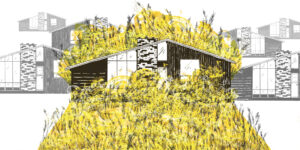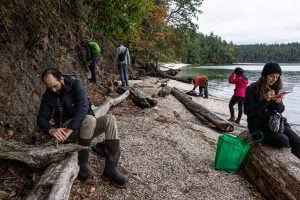
Environment
The sixth extinction
The planet is in the midst of drastic biodiversity loss that some experts think may be the next great species die-off. How did we get here and what can be done about it?
- 4895 words
- 20 minutes
Wildlife

A pair of snails that rely on the last remnants of mature forest near Lake Erie. A fish that grows to less than 10 centimetres in length and lives in just one lake near Vancouver. And a globally rare moss that only grows on one square metre of vertical limestone cliff in Haida Gwaii, British Columbia. They’re almost certainly not what comes to mind when most Canadians think of endangered species, yet they’re among a diverse group of small but fascinating plants and animals whose conservation status was assessed at the most recent meeting of the Committee on the Status of Endangered Wildlife in Canada, each with their own story to tell about the importance of biodiversity conservation.
COSEWIC is an independent body of experts from across Canada, many of them volunteers, who meet twice a year to review the latest evidence on wildlife species that are already at risk or may become so. Species are prioritized for assessment based on a range of factors including how much data is available, how threatened they are and whether they’re endemic to Canada. It was just a coincidence that this time, nearly half of the species on the docket were small, obscure species with limited ranges, says COSEWIC chair John Reynolds. But just because they’re small doesn’t mean they’re insignificant.
Take the slender yoke-moss, which grows on a single square metre of cliff face in Haida Gwaii. It has a far-flung global distribution, but is rare wherever it’s found. Almost nothing is known about how it reproduces or how it spread. It likes open, sunny spots, but trees have begun to grow over its cliff-side perch, allowing shade-loving algae and lichens to invade. It’s almost certainly on its way out, so COSEWIC has assessed it as endangered. That raises interesting questions for conservation biologists, says Reynolds.
“Will the world stop turning if that moss disappears? No, but we lose a really fascinating part of our natural heritage when it goes,” he says. “It also makes me ask, ‘what else might have been overlooked? How many other obscure or inconspicuous plants and animals and insects are out there waiting for us to discover them?’ ”
COSEWIC has no power to protect endangered or threatened species; it can only make assessments, then turn that information over to the federal government, which in turn decides whether or not to enact formal protections under the Species at Risk Act. Regardless, the committee’s semi-annual meetings are an opportunity for its members to raise public awareness about some lesser-known facets of Canada’s biodiversity.
At last week’s meeting, Jana Vamosi, a professor of plant biodiversity at the University of Calgary and co-chair of COSEWIC’s vascular plants subcommittee, brought forward a newly discovered plant called Puvirnituq mountain draba. Discovered in 2011, the tiny mustard plant grows on just two hills near the Deception River in Nunavik (northern Quebec) that are covered with a bright orange gravel. It may also exist where similar geological conditions are found, such as in Nunavut or northern Newfoundland, but field research in the North is costly and difficult.
So far, draba faces few human threats, and may withstand the impacts of climate change thanks to its highly specialized habitat. But because of its limited range, COSEWIC has assessed it as being of Special Concern. That designation can be used to motivate further monitoring and evidence-gathering to determine whether a species is in decline, says Vamosi.
Additionally, for any development project that requires an environmental assessment, developers need to list all at-risk species that might be affected, including Special Concern species. “People wouldn’t be charged with an offence for killing a species or destroying its critical habitat when it comes to Special Concern species, but they do have to acknowledge activities that might affect them,” says Vamosi.
But do species like slender yoke-moss or Puvirnituq mountain draba or the endangered toothed globe and shagreen snails really matter to the bigger picture of wildlife conservation? Both Reynolds and Vamosi say it depends on the value you place on nature.
“When we look deeper into all these species, they do play some role in their respective ecosystems, even if it’s a couple of links away from something we see value in. A particular plant species might feed an insect that feeds a bird that’s important for dispersing fruit, for example,” says Vamosi.
Then there’s the philosophical argument, which is that species have intrinsic value apart from the ecosystem services they may perform for humans.
“Most people, when they’re kids, tend to be fascinated by nature. Some people never lose that curiosity. The point we’re trying to make [as a committee] is that we have stories to tell about species people have never heard of,” says Reynolds.
Adds Vamosi: “These species share our planet, and they have some agency and right to live their lives free of human intrusion.”
Are you passionate about Canadian geography?
You can support Canadian Geographic in 3 ways:

Environment
The planet is in the midst of drastic biodiversity loss that some experts think may be the next great species die-off. How did we get here and what can be done about it?

Wildlife
By understanding why animals do what they do, we can better protect them while making people care

Environment
As cities and towns continue to expand into our wild landscapes, conservation gardens can provide refuge for Canada’s plummeting biodiversity

People & Culture
Naming leads to knowing, which leads to understanding. Residents of a small British Columbia island take to the forests and beaches to connect with their nonhuman neighbours